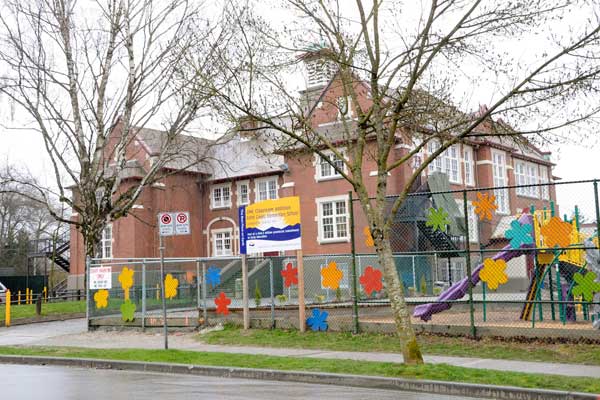

[Editors Note: this is a revised version of a four-piece series originally published on Planning Pool]
Recent years have not been easy for public schools in Vancouver. A local newspaper identified threatened school closures as one of the top news stories of 2010. While the Vancouver Board of Education finally placed a moratorium on proceeding with school closures until 2012, the need to consider closing schools at all seems strange in a city whose overall population is growing by over 1% annually.
Demographic shift – “low birth rates and an aging population” – is perhaps the most frequently cited explanation for school closures and other measures to scale back school services. The overall population of Canada, like that of many other “developed” countries, is indeed aging. But local demographic trends are more nuanced. Adults of all ages selectively decide where within a city, region or country to settle, whether they have kids or not.
The Vancouver School Board’s complaints of declining enrolment made me wonder whether families with kids might be leaving the City of Vancouver for its suburbs in increasing numbers. This would leave the central City with a population made up of even greater proportions of childless households and retirees than could be explained by nation-wide demographic shift.
Demographic data reveal that the proportion of the population made up of school-aged children has generally declined since 1986 in both the central City of Vancouver (pop. 600,000) and in the rest of the region. (Metro Vancouver has a population of about 2 million.) As expected, demographic shift occurring in Vancouver. Also unsurprisingly, school-aged children have consistently made up a smaller proportion of the population in the central City of Vancouver than in the rest of the region, which is generally more suburban in character.

Unfortunately, for the Vancouver School Board, the percentage of the population represented by school-aged children has declined at an even faster rate in the City of Vancouver (falling from 14.8% in 1986 to 13.6% in 2006) than in the rest of the region (where it fell from 19.9% to 19.4%).* This could be interpreted to support a hypothesis that families with children are increasingly leaving the central City of Vancouver for its suburbs. The more suburban City of Surrey (pop.400,000) manages to have the only public school district in British Columbia where enrolment is actually increasing.
There trends are not unique to Metro Vancouver. One analysis of 2006 Canadian census data showed that “27% of first-time parents made the move out the city and very few moved in.” A Statistics Canada report suggests that “one of the explanations for a younger population is that peripheral municipalities are favoured by households with couples and children”.
Across Canada, young families tend to depart from inner cities. Why might this be? A Vancouver-based twitter feed (right) proposed an educated guess.

For families with children to live in central cities like Vancouver, they need affordable and suitable family housing. As many young residents have been informing Vancouver City Council in response to the Cambie Corridor Plan, this type of housing is widely out of reach in Vancouver.
Affordability of Vancouver’s Family Housing
A Royal Bank of Canada Economics Research housing report recently determined Vancouver’s housing market to be the least affordable in Canada. The situation is most dire for the 35% of Metro Vancouver households that rent their dwelling. Virtually no purpose-built rental is currently being produced.
Single-family houses, which have traditional been homes for families, have become increasingly less affordable when compared to attached dwellings and apartments. Today, a typical Vancouver household would have to spend 78% of their income to carry the mortgage on an average bungalow.

In 2006, 30.2% of Vancouver’s rental households, as well as 9.9% of its owner households, experienced core housing need, which is a combined measure of unaffordability, crowding, and need for major repair.
Suitability of Vancouver’s Family Housing
Since single-family houses have become unaffordable for the majority of Vancouver families with children, what other suitable housing types have become available for this demographic group?
Multi-family housing comprises more than two-thirds of Vancouver housing starts. However, the typical Canadian urban condo averages only about 600 square feet. Three-bedroom apartments comprise only 2% of Vancouver apartment stock. Similar situations in other urban centres led a Toronto city councilor to observe, “We are generating the space to start families but not to house them.”

In 2009, Regarding Place Magazine analyzed the demographics of Vancouver’s neighbourhoods to identify concentrations of families with children. Researcher Erick Villagomez found that those areas of the city which had recently experienced significant redevelopment had “minimal population” of children 12 and under. Likewise, when considering the neighbourhoods containing the greatest proportion of Vancouver’s under-5 population, “all [… were found to be located in] single-family home communities.” These findings suggest that current models of housing development in Vancouver are failing to provide enough family-friendly alternatives to detached houses.
Many families with school-aged children cannot afford suitable dwelling space within central cities. Declining enrolments and threatened school closures in Vancouver’s school system, therefore, comprise more than a political, budgetary or demographic issue. They represent a long-range urban planning problem, and the challenge of finding models to enhance the affordability and suitability of family housing in inner cities.
Join is next week as we delve further into schools, housing and affordability.
****
METHODOLOGY & DATA. The geographical areas included in population counts for the Metro Vancouver region have shifted slightly over the years, meaning that attempts to compare changing numbers of children based on these data would be inaccurate. Instead, this analysis compares school-aged kids as a percentage of the entire population. Using population profile data for each census year since 1986 for both the City of Vancouver proper and for the Greater Vancouver Regional District, I calculated the school-aged population (kids aged 5 – 19), then divided that population by the total population that year to reveal the proportion of the population that was school-aged.




